EUDR for used goods - What applies to used tires and pallets?
EUDR - Reading time: 8 Min
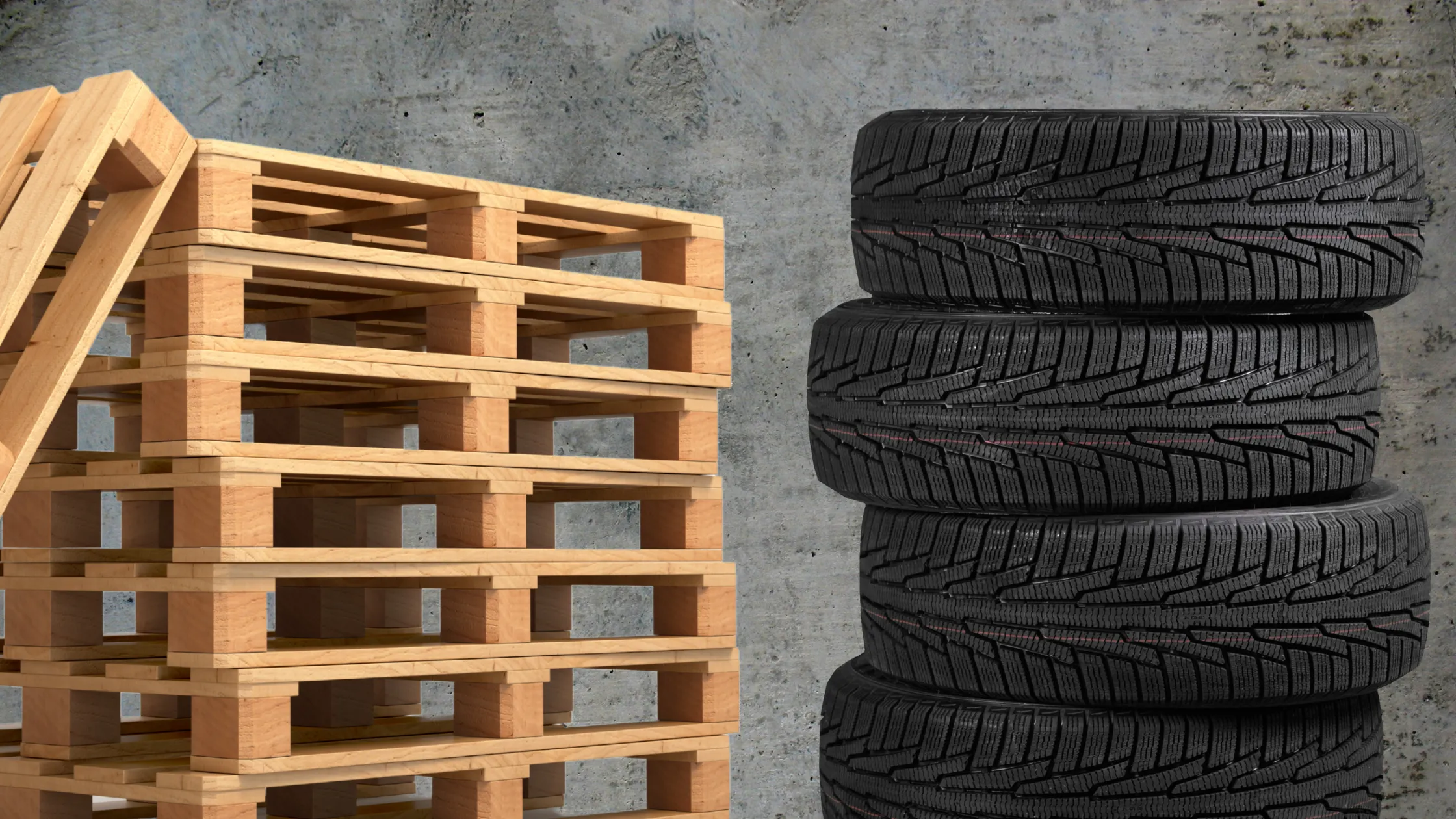
Since the EU Deforestation Regulation (EUDR) came into force, companies that trade in wood, rubber or their products have faced new challenges - especially when dealing with used goods. While the debate has so far focused on new products, the status of second-hand items such as truck tires or wooden pallets is increasingly causing uncertainty: do they also have to comply with the EUDR requirements? This article clarifies how the EUDR classifies used goods and when the regulation applies to used products. It also provides practical tips for companies when dealing with these goods.
Important facts at a glance
No. If a product, e.g. a tire or a pallet, was already lawfully placed on the EU internal market before June 29, 2023 or before, a new EUDR test is not required, even for resale, rental or export within the EU.
If it is subsequently significantly modified, e.g. by replacing load-bearing wooden parts on pallets or retreading tires with new natural rubber. Then it can be considered a "new product" and is again subject to the EUDR duty of care.
A modification is considered significant if it fundamentally changes the material composition or function of the product. Minor repairs, cleaning or testing do not count as such, but extensive modifications or upcycling do.
A complete collection of information on product launch and use is recommended - e.g. date of purchase, proof of origin, serial numbers, delivery receipts or maintenance history.
No. Used goods that have already been properly placed on the EU internal market can generally be exported from the EU without a new EUDR test - provided they have not been significantly modified.
In addition to documentation, clear communication along the supply chain is crucial - for example through clear product labeling and indication of the used status in invoices, delivery bills or digital systems.
Executive Summary
The EU Deforestation Regulation (EUDR ) obliges companies to prove the legal and deforestation-free origin of certain raw materials, such as wood, cocoa, coffee and natural rubber, before products made from them are placed on the EU internal market for the first time. As a rule, this obligation does not apply to used goods, such as tires or pallets, if they were already properly imported before 29 June 2023 or before. No re-testing is required for resales, rentals or exports within the EU either. However, the prerequisite for this is that the products have not been significantly modified since then.
A significant change occurs when new, EUDR-relevant materials are introduced. This can be the case, for example, when replacing load-bearing wooden elements on pallets or when retreading tires with fresh natural rubber. The goods can then be considered a "new product" and be subject to EUDR. The decisive factor here is the extent of the change and whether the function or identity of the product changes noticeably.
Companies should therefore attach importance to proper documentation of the original product launch and use. This includes evidence of the initial purchase, the origin, any maintenance steps or serial numbers. Clear communication along the supply chain is equally important in order to clearly identify new and used goods and avoid misunderstandings. This effectively minimizes regulatory risks when dealing with second-hand products.
Used goods and the EUDR - an often overlooked special case
Trade in used goods has a long tradition in Europe and is becoming increasingly important due to the scarcity of resources and sustainability goals. Products such as tires, containers or transport pallets in particular regularly go through several usage cycles. Uncertainty is now arising in the wake of the EUDR: Does the same duty of care apply to any resale or export of a used good as to new goods? Many companies are confronted with inventories for which only incomplete preliminary information is available - especially if products entered the EU years ago.
This uncertainty is omnipresent in the supply chain. On the one hand, there is often a lack of transparency as to when exactly a product was "placed on the market" for the first time. On the other hand, there are many different constellations in practice: Products are repaired, refurbished or supplemented with new parts and then resold. While the regulation primarily addresses the direct origin of raw materials, the question arises as to whether and when used goods are considered "new" products within the meaning of the EUDR.
What does the regulation say about used goods?
Focus of the regulation: avoiding deforestation through primary raw materials
The aim of the Deforestation Regulation ( EUDR for short) is to keep products with a risk of deforestation and forest degradation out of the European internal market as far as possible. This includes not only raw materials such as soya, coffee, palm oil, cattle or wood, but also products made from these, such as furniture, paper products or tires made from natural rubber. Essentially, the regulation requires that only deforestation-free products may be marketed, sold or exported within the EU. Companies must rely on verifiable evidence to prove that their products are deforestation-free.
As a rule, companies are obliged to carry out a comprehensive due diligence and risk analysis. This includes the traceability of the origin of raw materials, compliance with local laws and the submission of due diligence declarations as well as the submission of comprehensive verification documents. The due diligence obligation applies both to new products and to processed or composite articles that are associated with the relevant products - provided they are placed on the Union market for the first time.
"Placing on the market" within the meaning of the EUDR
A central element of the EUDR is the term "placing on the market". According to the content of Article 2 No. 16 of the Regulation, this means: "any first making available of a relevant product on the Union market for distribution or use." The decisive factor is therefore when a product - be it a raw material, an individual part or a finished product - is made available on the market for the first time within the scope of the Regulation.
If a product was already imported in accordance with the law before the EUDR came into force or elsewhere in the internal market, it is deemed to have been "placed on the market". Such goods do not have to be checked again. All subsequent changes of ownership, resale, rental or storage of goods that have already been imported for the first time do not trigger a new due diligence obligation from an EUDR perspective. However, an exception is conceivable if the product is considered "new" again due to repair, conversion or substantial modification.
When are used goods considered "no longer affected"?
In practice, this means that products that were "placed on the market" in an EU member state before the EUDR came into force are not subject to a new EUDR test, even if they are resold, rented or exported. This applies analogously if a product moves from buyer to buyer, for example in wholesale, in the second-hand business or in cross-border trade from country to country within the EU.
The decisive factor is whether a significant processing or treatment step has taken place in the meantime. If the product is merely stored, cleaned or tested for resale, it remains a "used" product from an EUDR perspective. Only if a new composition (e.g. by adding new components or materials such as fresh natural rubber or new wood) is created in the course of a repair, replacement or conversion could the product be classified as "newly placed on the market" from a compliance perspective. In such cases, a new EUDR test is essential.
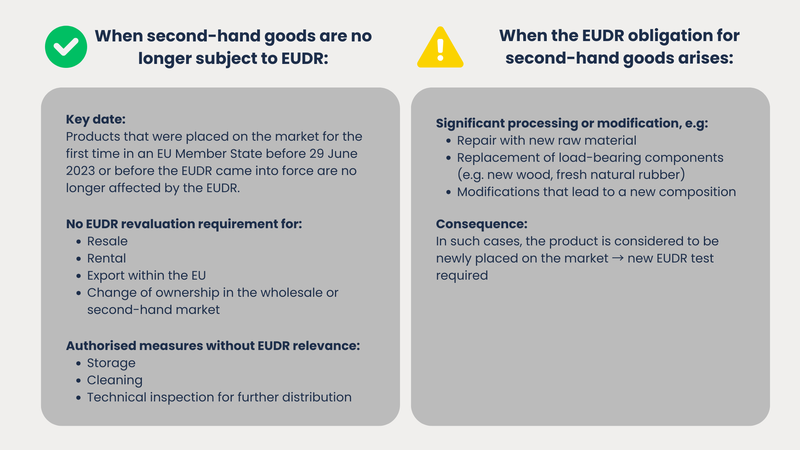
Case study 1: Used tires
Why tires are generally EUDR-relevant
Tires consist to a large extent of natural rubber, which is explicitly listed as risk-relevant in Annex I of the EUDR. According to estimates by the International Rubber Study Group, the annual global production of natural rubber amounts to around 14 million tons - the majority of which is harvested in Asia. According to a study by the Vrije University of Amsterdam, five percent of the natural rubber produced worldwide is used for tires for European vehicles - primarily for car tires. As forests were deliberately cleared for many plantation areas, the EU explicitly classifies tires as subject to EUDR if they are sold in the EU for the first time.
New tire importers must therefore ensure that both the rubber material obtained and the production process can be documented as deforestation-free and legal in accordance with the EUDR. The verification requirements are considerable: in addition to proof of the country of origin, traceability to the parcel of land on which the rubber was grown is also required.
When used tires are considered "not affected"
Anyone who resells, rents or exports used tires within the EU does not have to undergo another EUDR due diligence test. The prerequisite for this is that these tires have already been placed on the market in the European single market in accordance with the regulations in force at that time. They are therefore considered "existing goods" and are not subject to any new reporting or documentation requirements or risk assessments.
The typical example: A truck fleet renews its tires after three years and sells the tires to a second-hand dealer or to other European countries. As the tires have already been imported and taxed as a new product, the goods are treated as "used" in every subsequent trade transaction and are no longer subject to compliance from an EUDR perspective. This exemption also applies to tires that are exported within the EU or transferred between companies, as long as no further processing has taken place.
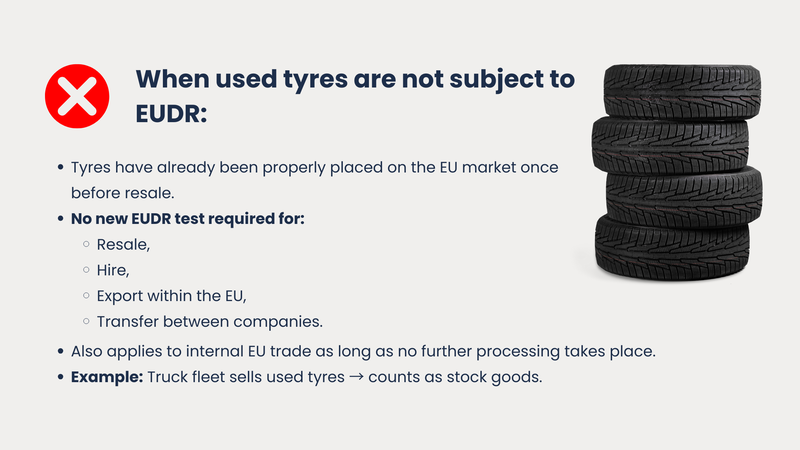
Exceptional case: Retreaded tires
However, retreaded tires are handled differently. Here, the worn tire substructure ("carcass") is reconditioned, vulcanized and provided with a new tread layer. Depending on the extent of the processing, this process can be classified as the manufacture of a "new product" within the meaning of the EUDR. The decisive factor is how much new material - in particular fresh natural rubber or vulcanized rubber - is used and whether the finished product can be functionally and legally assessed as an independent product.
In practice, the inspection authorities and customs authorities are often guided by the relevant change in accordance with the Customs Code and the "materiality criterion". If only a minor repair is carried out without significantly changing the identity of the tire, it remains classified as used goods. However, if extensive retreading or reconstruction is carried out, the tire is considered a new product and is therefore subject to EUDR. A detailed examination of each individual case is therefore required.
Case study 2: Used pallets
New pallets generally subject to EUDR as a wood product
Wood products play a central role in the context of the EUDR, as raw wood is a potential driver of global deforestation and is one of the relevant raw materials covered by the regulation. Transport pallets, in particular the widely used Euro pallets, are made of various types of wood and are produced, exchanged and reused in Europe by the millions. The majority of pallets circulating in the EU originate from domestic or European production. Nevertheless, some pallets from non-European sources, such as Asia or South America, are also used, which can be traced back to deliveries or disposable packaging.
The full EUDR due diligence obligation therefore applies to new pallets, regardless of whether they are exchangeable or disposable. Manufacturers and importers must prove the legal and deforestation-free origin of the wood during production by means of suitable documents and declarations before the pallets can be sold or passed on in the EU.
Used pallets: When does the exception apply in the EU market?
Once pallets have been made available as a finished product on the EU internal market, for example by a European manufacturer or importer, they are considered to have been "placed on the market". With this introduction into the internal market, they are classified as used goods from an EUDR perspective for all subsequent circulation processes, for example when trading, renting, exchanging or exporting within the internal market, and are generally not subject to EUDR again.
This applies in particular to the widespread exchange networks such as the open Euro pallet pool, in which millions of pallets have been in circulation for decades. Customs and inspectors also recognize that no new EUDR due diligence obligation arises for pallets that have already been introduced into the economic cycle in Europe as long as no changes are made to the essential components of the pallet.
If a used pallet is merely cleaned, checked, marked or pooled, it continues to be traded as a component part of an existing product. The replacement of small parts such as nails, connectors or color codes also has no EUDR consequences.
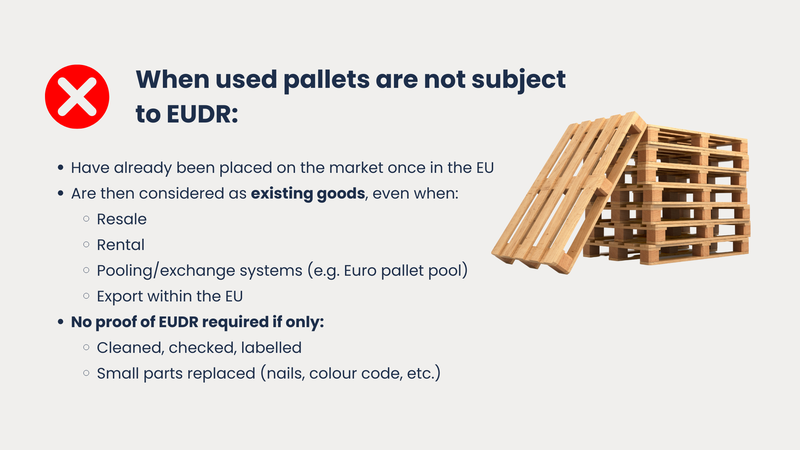
When pallets can be relevant after all
Nevertheless, there are exceptions: If essential wooden elements - such as support or cover boards - are replaced in the course of repairs or a used pallet is significantly modified with new raw material, there is an increased risk that the pallet will be classified as a "new product" in a modified form according to the regulatory interpretation. In cases of so-called upcycling, where used pallets are converted into other products such as furniture, structures or structural elements, the EUDR obligation question arises again.
A detailed examination of the individual case is recommended here: If the modification is only made to restore the original functionality, without any substantial addition of material, it can still be legally considered a used pallet. However, if new raw materials are added on a larger scale and the product is given a new function or identity as a result of the modification, the EUDR testing obligation applies again. This means that commercial upcycling providers in particular need to take action.
Summary: When are second-hand goods subject to EUDR - and when are they not?
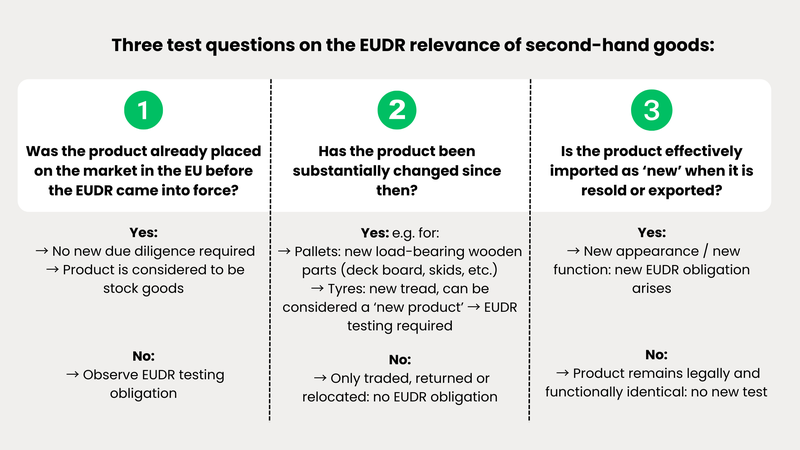
Decision logic for practice
Three key questions determine whether and how the EUDR applies to second-hand goods.
- Firstly, it must be clarified whether the product concerned was first made available on the EU internal market before the EUDR came into force or at an earlier date. If this is the case, there is generally no need for any new due diligence and risk assessment under the regulation.
- Secondly, it must be checked whether a substantial change has been made to the product in the interim. Only products that have remained the same in their basic composition and are merely traded, passed on or put back into circulation as part of a return are exempt from a new EUDR test. If new wooden planks, runners or other load-bearing elements are replaced on pallets or a new tread is applied to tires, this can be considered a "new product" relevant to the manufacturing process.
- Thirdly, attention must be paid to whether the product has been redesigned during its transfer or export in such a way that it effectively reappears on the internal market as a new product. As soon as this is the case, the EUDR duty of care begins again in accordance with the applicable rules.
Overview: Implementation checklist for companies
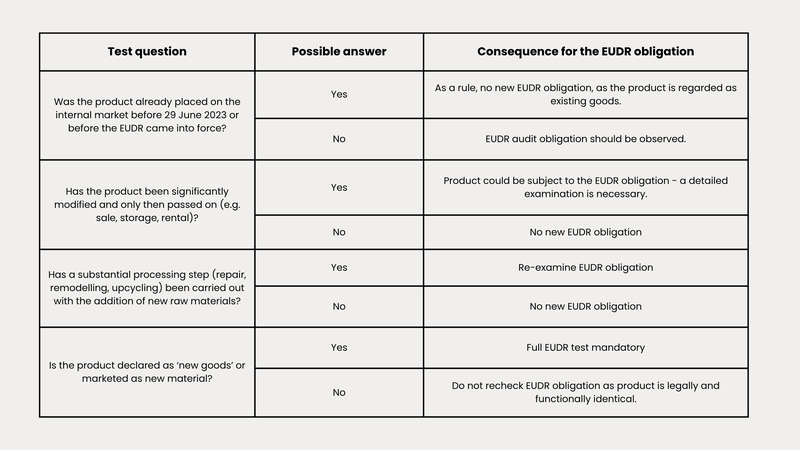
Recommendations for companies
Document evidence of prior use
Large, medium-sized and small companies that trade in used goods such as tires or pallets should attach importance to complete documentation of product introduction and use. This collection of information includes details such as the date and proof of first purchase, the clear origin from the EU internal market, any existing serial numbers or proof of delivery as well as descriptions of previous use and any maintenance steps. The creation of a central register in which this product information is stored has already proven its worth in practice. In this way, gaps in evidence can be minimized even years later and official inquiries can be answered quickly.
Strengthen communication with suppliers and customers
Clean communication along the entire supply chain is just as important. Companies should clearly indicate to suppliers and downstream business partners at an early stage whether they are dealing with new or used items. This can be done as part of invoicing, in delivery bills or technical product descriptions. It also makes sense to clearly label products, for example with barcode tags, labels or entries in the digital merchandise management system. This is the only way to avoid queries and misunderstandings.
Check special cases at an early stage
Borderline cases such as retreaded tires, repaired pallets with replacement boards or industrially refurbished components should be subjected to an in-depth examination at an early stage. In particular, companies that specialize in refurbishing, upcycling or the series repair of industrial goods must document precisely for each product whether and which new materials with EUDR-relevant raw material origins were used. If in doubt, specialist or legal advice should be sought in good time. It may also be advisable to contact local authorities or customs if there is uncertainty about the classification of individual production steps.
Conclusion
As a result, used products such as tires or pallets are generally no longer subject to EUDR as long as they have already been properly placed on the EU market and no substantial changes have been made to the material base. Nevertheless, companies should not rely on this exemption across the board - especially if repair, refinement or conversion steps have been carried out that result in a "new product" character. The key factors for legally compliant handling of used goods are complete documentation, plausible product classification and - where possible - proactive coordination with authorities or customs. Compliance officers and product managers in particular should align internal processes to be able to quickly identify EUDR-relevant processes and keep meaningful evidence of this to hand.
FAQ
Significant changes are processing steps that change the fundamental identity of the product - for example, by adding new raw materials (e.g. new wood for pallets or fresh rubber for tires) or converting to a different product type. As a rule, this does not include mere cleaning or maintenance.
No, a minor repair - such as repairing minor damage without using new raw material - does not change the status of the tire. It remains exempt from the EUDR as used goods. A complete retread, on the other hand, may require a new assessment in individual cases.
No, used goods that have already been placed on the market within the EU can generally be exported without a new EUDR test - as long as they have not been significantly modified or reassembled since then.
Careful documentation of previous use, precise classification of used products and transparent communication along the supply chain can largely prevent unwanted compliance risks.
Yes, the greater the proportion of new, EUDR-relevant material in the remanufacturing of a product, the more likely it is to be classified as a new product and therefore subject to EUDR. Used products without substantial material additions are generally exempt.
